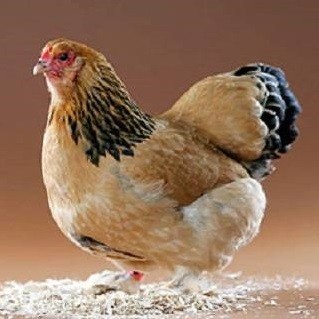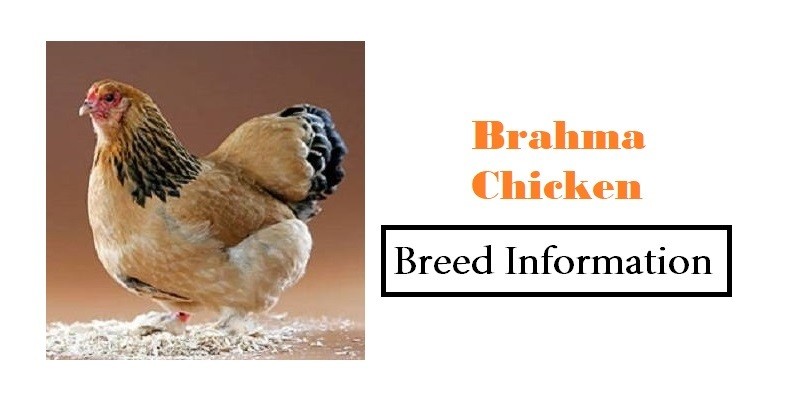Last Updated on February 9, 2021 by Pauline G. Carter
As the name suggests, the Brahma Chicken breed originated from India. They were introduced and developed in the USA when some merchants imported them from the Chinese port of Shanghai. They are primarily bred for meat production. They are called gentle giants. Their legs and feet are feathered, and they have profuse and fluffy feathering.
From 1850 to about 1930 eras, Brahma Chickens were the primary source of meat breed in the USA. From then on, it became largely available to all meat lovers. Lightweight of this chicken breed makes ideal pets because they are friendly, calm, and easy to handle.
Brahma Chicken | Breed Profile

| Country of origin: | United States |
| Primary use: | Meat |
| Weight: | Male: 5.5 kg, Female: 4.5 kg |
| Temperament: | Calm |
| Recognized Varieties: | Dark, Buff, Light |
| Egg production (annual): | 150 |
| Egg color: | Brown |
| Egg size: | Large |
| Comb type: | Pea |
Characteristics Of The Brahma Chicken
Brahma chicken size averages from 4-5kg for hens and 5.5 kg for cocks. Yes, they are quite heavy compared to other chicken breeds. This signifies they are meaty. Though there were only Light and Dark Brahma varieties, there are 7 colors recorded from various breeders. They are black, blue-columbian, buff-columbian, dark, gold, light or white.
Brahma chicken eggs average about 120 brown eggs per year and the egg sizes are approximately 55-60 grams. This large egg size needs constant checking and protection against their mother to avoid tramping on them during the first few days after they are hatched. Hens have the tendency to go broody during summer.
They are hardy in winter, docile and they are calm, curious, and friendly that makes them a great family pet. Brahma chicken height looks intimidating at first glance because of their large size. However, they are harmless in general.
Light, dark and buff are the 3 feather pattern of Brahma chickens. There is a contract in black in white in Light Brahmas with a grayish undertone. There is a black striping on the hackle feathers. Saddle area has a little striping, too. Their black tail is laced with white feathers.
The dark Brahma has silver hackles and a black striped saddle. They have solid silver shoulder and solid black on their tail, breast, and body. They require double mating to come up with the best coloring.
Buff Brahmas are the same as the light ones. Instead of white, it is buff. It is the most favored variety due to its warm coloration.
Behavior/ Temperament/ Use
Thanks to the Brahma chicken size, they are rather large! That is why they are called the King of Chickens before the coming of the Jersey Giant chicken breed. This makes them great producers of meat. Aside from their meat, their ability to lay 140 to 150 eggs per year is one of the reasons why it is great to keep them in our backyards.
They come handy during the winter season. It is always a great feeling when we just pick our food from our very own backyard!
As mentioned, hens tend to be broody during summer-only because they are protective of their chicks. Take note that hens can start laying eggs from 6 to seven months. A hen can produce 3 to 4 eggs per week and their laying season preference is from October to May.
Brahma chickens are also great foragers. They can attend to their needs. Soil and environment around them must be cool climate, generally dry and moist. Wet and muddy areas can lead to foot problems for these chickens.
What We Liked/Pros
- Feathered feet help to keep the dirt away during spring.
- Feathered feet help them carry on during cold weather.
- With calm temperament, gentle, and friendly.
- They are not flocking bully.
- Large egg size.
- Meaty and lay a great number of brown eggs.
- With easy recognizable feather patterns – light, dark and buff.
- Easily contained for they are not flighty.
What we don’t like/Cons
- Cost of feeds may differ from standard chickens as they will eat more.
- Needs to modify the coop due to their large size.
- Wet and swampy areas must be avoided to avoid foot problems.
- Their feathering poses as problems on winter as they can lead to frostbites in freezing temperatures. Feathered feet need special attention and care.
- Lice and mice may thrive on their feathers.
- Expectedly during the spring season, roosters tend to suffer a little from testosterone overload.
- Before hens can start laying, it can take 6 to 7 months.
Is Brahma Chicken Good for you?
Yes, if you like large hens at your backyard or with your flock; and if you have bigger space for them. They produce great meat and eggs. They are domestic animals and will never pose a problem. Better yet, consider the pros and cons!
DON’T MISS
- Ancona Chicken Breed Information
- Frizzle Chicken Breed Information
- Plymouth Rock Chicken Breed Information


